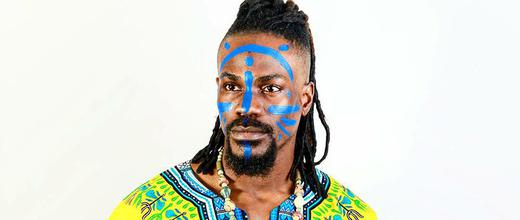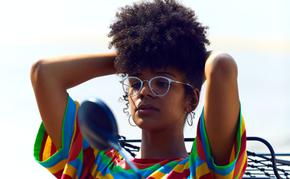The views expressed in our content reflect individual perspectives and do not represent the authoritative views of the Baha'i Faith.
Deltin Sejour received his early training in martial arts—but discovered his calling in dance at the age of 13, during a dance battle with his friends.
Born and raised in Freeport Grand Bahama, The Bahamas, Deltin’s focus soon shifted, and he began intense training in theatre and dance which eventually landed him at the School of Toronto Dance Theatre and in the Dance Performance program at George Brown College in Canada. Deltin also spent time studying various aspects of yoga, mind and movement, and travelled to India to gain further instructor training.
As an emerging dance and movement artist, Deltin continues his education by collaborating and creating meaningful, thoughtful, physical and engaging work in various forms of diverse dance. He longs to serve humanity, so has also become heavily involved in the Baha’i Junior Youth Spiritual Empowerment Program in his community.
I had the opportunity to meet with Deltin in his apartment in St. James Town, an inner city neighborhood in Toronto, to learn about his journey through dance, and how he finds unique and creative ways to incorporate faith into movement, and movement into community-building.
Q: You’ve just finished a busy performing season, could you share a bit about what you’ve been up to in the last couple months?
A: I just finished my program, Dance Performance, at George Brown College. I’ve also been working on different projects with various choreographers around the city, so lots of rehearsals and dancing. Living as a freelance artist in Toronto, you generally have to be prepared to work on a bunch of projects at the same time, and spend the rest of the time looking for work when there’s not much going on.
Q: You’re a professional dancer but you started your training in martial arts, and took a slight detour to study history and psychology in university before entering the professional dance world. Can you walk us through your artistic journey?
A: I spent a lot of my free time while growing up studying martial arts, which stemmed from a fascination with Bruce Lee. My group of friends, however, were really into this emerging hip hop dance form at the time called Krump. They would gather in each other’s homes every day after school and on weekends to put on Krump parties, and I began to feel left out, so I started to approach dance from the perspective of wanting to fit in and be included. I began to take classes and eventually took part in a Krump battle, which was not a good showing. So I took some more time away to hone my skills and dance eventually became my life. I took a slight detour and completed half a degree in history and psychology at the University of the Bahamas, but during a very grueling calculus class I realized that this wasn’t what I wanted to be doing with my life. I wanted to be serving my community as an artist but also as a junior youth “animator”—a facilitator of Baha’i junior youth classes. The following words of Abdu’l-Baha encouraged me to focus on my art, and strive to perfect it, because this in itself was an act of worship:
I rejoice to hear that thou takest pains with thine art, for in this wonderful new age, art is worship. The more thou strivest to perfect it, the closer wilt thou come to God. What bestowal could be greater than this, that one’s art should be even as the act of worshipping the Lord? That is to say, when thy fingers grasp the paintbrush, it is as if thou wert at prayer in the Temple. – Abdu’l-Baha, from a tablet to an individual Baha’i.
Q: So with that spiritual motivation, what aspects of dance are you attracted to stylistically? What authentically moves you?
A: I currently spend a lot of time in the improvisational field of modern and Afro-Caribbean dance, which are motivated by physical expression and ritualistic practices. I’m really fascinated by dance in the cultural context that shows the universality of human movement and the body. As a dancer I’m also really fascinated by how I can use my feelings and emotions as an instrument for movement, using my body as a dynamic object. This type of movement has no gender or connotation outside of it being a really exciting and visceral experience. Viewing gender equality in dance is a very common theme the Toronto modern dance community shares, and there are a lot of artists and choreographers learning how to portray equality through dance, which I love to be a part of as it’s very in line with my beliefs as a Baha’i:
Until the reality of equality between man and woman is fully established and attained, the highest social development of mankind is not possible. Even granted that woman is inferior to man in some degree of capacity or accomplishment, this or any other distinction would continue to be productive of discord and trouble. The only remedy is education, opportunity; for equality means equal qualification. – Abdu’l-Baha, The Promulgation of Universal Peace, p. 76.
Q: Do you believe that dance is an inclusive art form, or does it present some limitations?
A: Certain socio-economic boundaries either prohibit or inhibit an individual from being able to dance, and one of those is having the finances to access dance to begin with. I was really lucky in the Bahamas to have access, and was given the opportunity to attend dance classes for free. Here in Toronto the cost of classes and just accessing the art form in itself is really, really high, and not a priority for people with limited financial means. This makes it very limiting, because you begin to only see the faces of those with access to finances in the dance world. So I try to integrate my dance work into my service with youth in the local community, so they can feel and experience the joy of movement.
Q: Can you share a bit more about how you’ve been able to use your skills as a dancer, in service to your community of St. James Town?
A: Definitely. As an animator of the Junior Youth Spiritual Empowerment Program and Children’s’ Class teacher, I have the opportunity to work with children and youth to explore ways they can develop their intellectual, spiritual and creative powers of expression. We sometimes do simple movement activities to help them get into their bodies. I’ll play some drums and they’ll have so much fun. They’re used to doing activities at school that are more goal-oriented, but with our movement exercises they just get to express themselves through movement, without any ulterior motive. Education in the arts is a fundamental practice in the Baha’i Faith, and I’m always in search of new and creative ways to integrate arts and dance into my service:
O ye recipients of the favours of God! In this new and wondrous Age, the unshakeable foundation is the teaching of sciences and arts. According to explicit Holy Texts, every child must be taught crafts and arts, to the degree that is needful. Wherefore, in every city and village, schools must be established and every child in that city or village is to engage in study to the necessary degree. – Abdu’l-Baha, Selections from the Writings of Abdu’l-Baha, pp. 134-135.
Q: What would be your advice to someone who wants to pursue a career in dance?
 A: Think about your options. There are so many things that have to come together for someone to pursue dance. There is a lot of pressure on dancers to be very strong and technical. You have to be financially in the right place, your body has to be in the right place, you have to get into the right school, be around the right support system. Evaluating your options is really important. In addition, knowing that there is always something else that you can do frees you up from all the self-doubt and all of the pressures, and helps you know that you’re doing this because you actually love it.
A: Think about your options. There are so many things that have to come together for someone to pursue dance. There is a lot of pressure on dancers to be very strong and technical. You have to be financially in the right place, your body has to be in the right place, you have to get into the right school, be around the right support system. Evaluating your options is really important. In addition, knowing that there is always something else that you can do frees you up from all the self-doubt and all of the pressures, and helps you know that you’re doing this because you actually love it.
Q: So what other skills have you been working on outside of dance?
A: I’m a certified yoga instructor. I’m very interested in psychology and physiology, and I expect in the future that I’ll work in some sort of field that relates to the human body and mind. I try to stay aware of confirmations and be detached. Right now as a dancer I feel very strong and healthy, but at any point I could experience an injury and be forced to re-evaluate my goals and objectives. I try to remain humble and grateful for every day that I’m able to dance, as it’s a gift.
Q: What projects do you have on the horizon?
A: I always have a bunch of projects on the go, but now have a notable one with a company in Toronto called Kaeja d’Dance. They have a really interesting production about an expression of who we are, our family history and the reality that we live today. It will become a sort of collage of the human experience and the universality of who we are and how life and experience shapes us.
Q: How can our readers learn more about your work?
A: It’s really easy to follow me on social media through Facebook or Instagram.


















Comments
Sign in or create an account
Continue with Facebookor